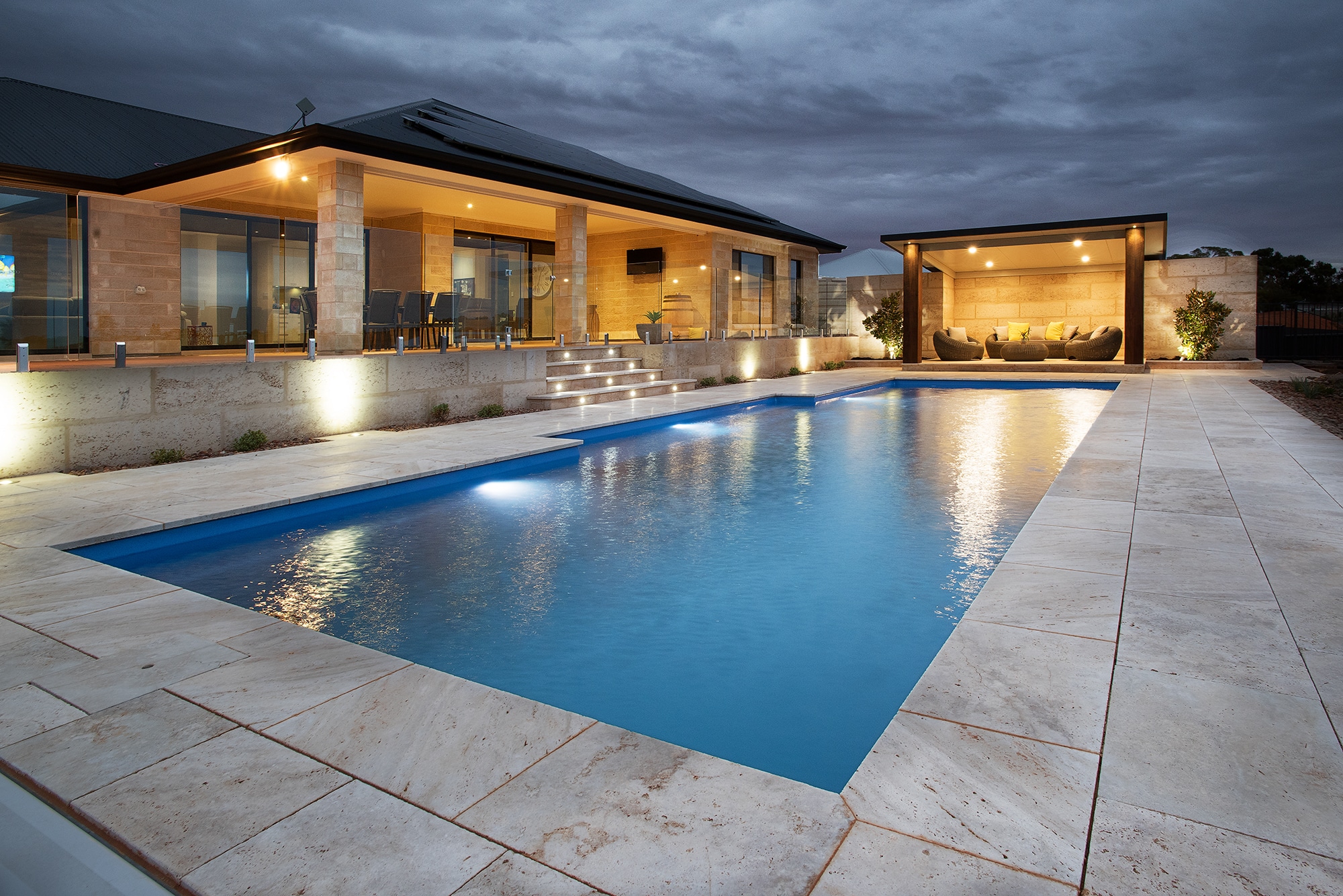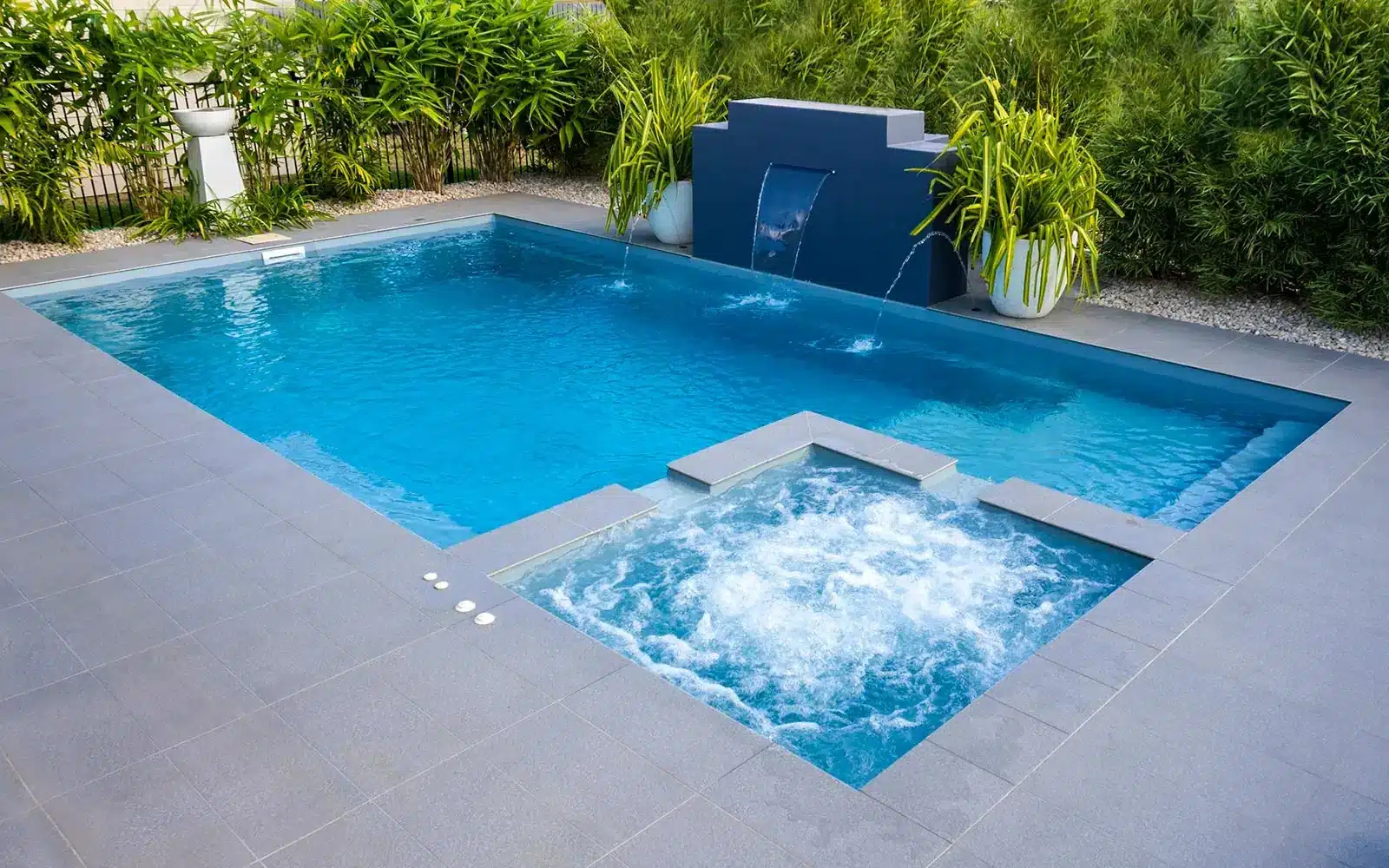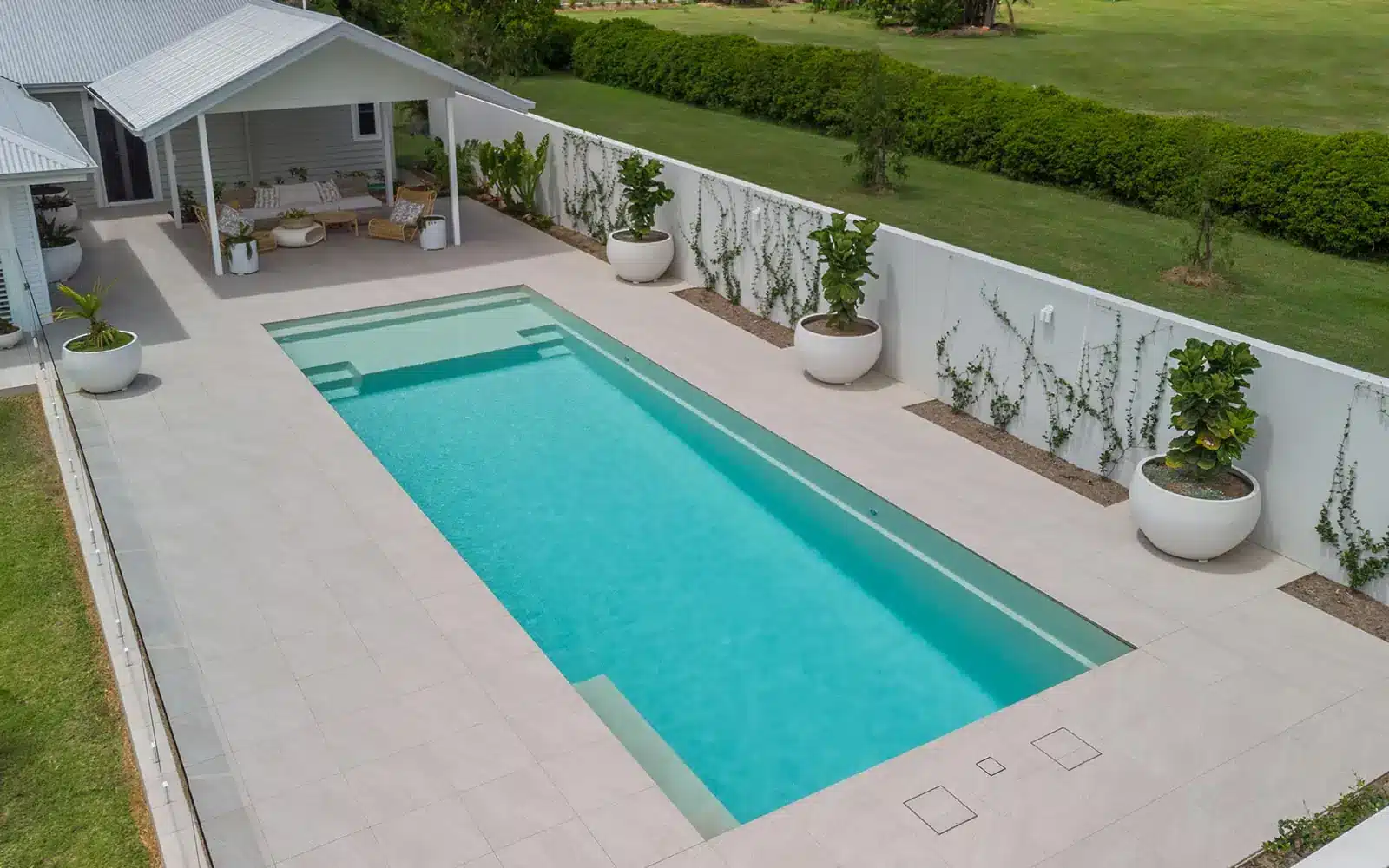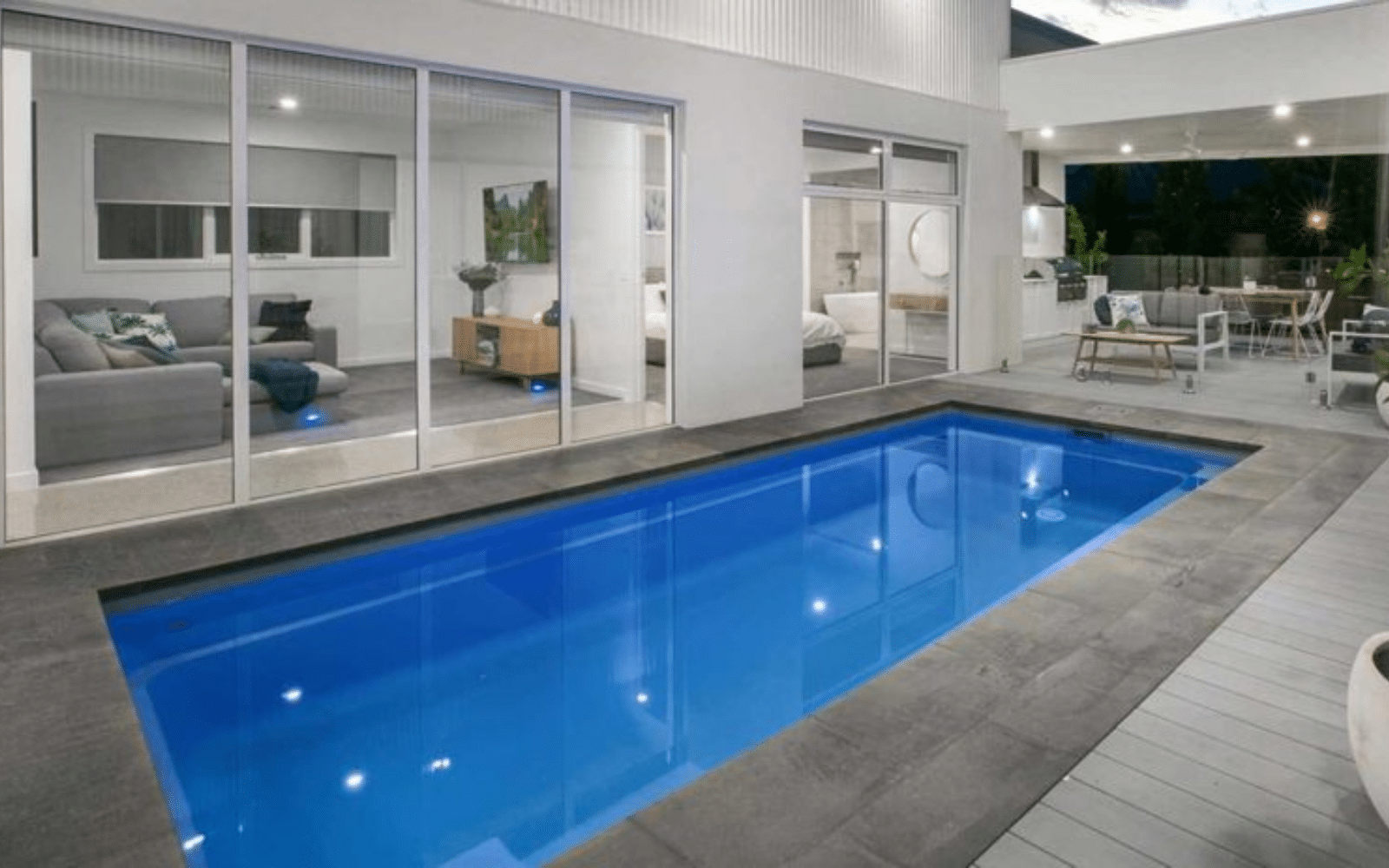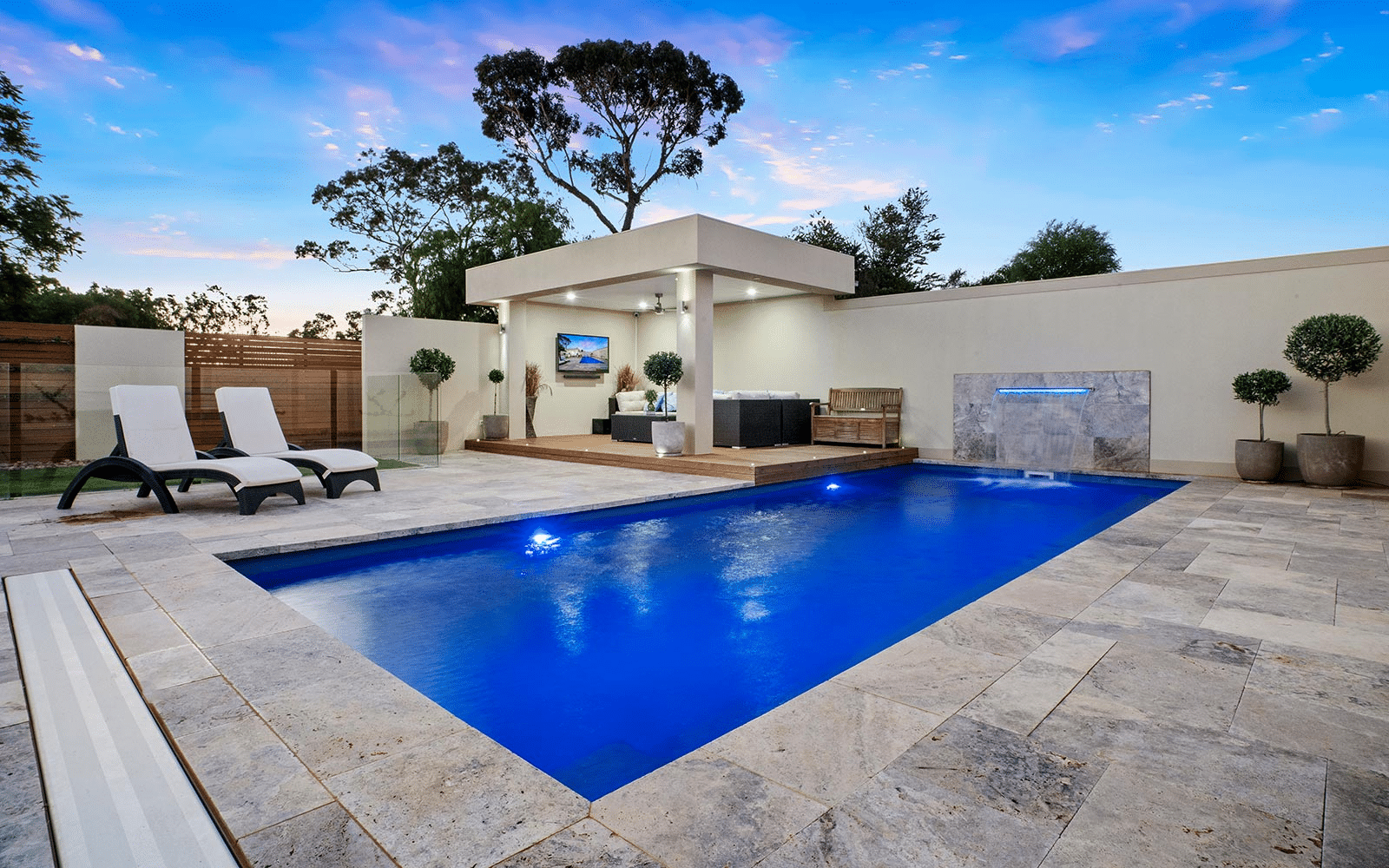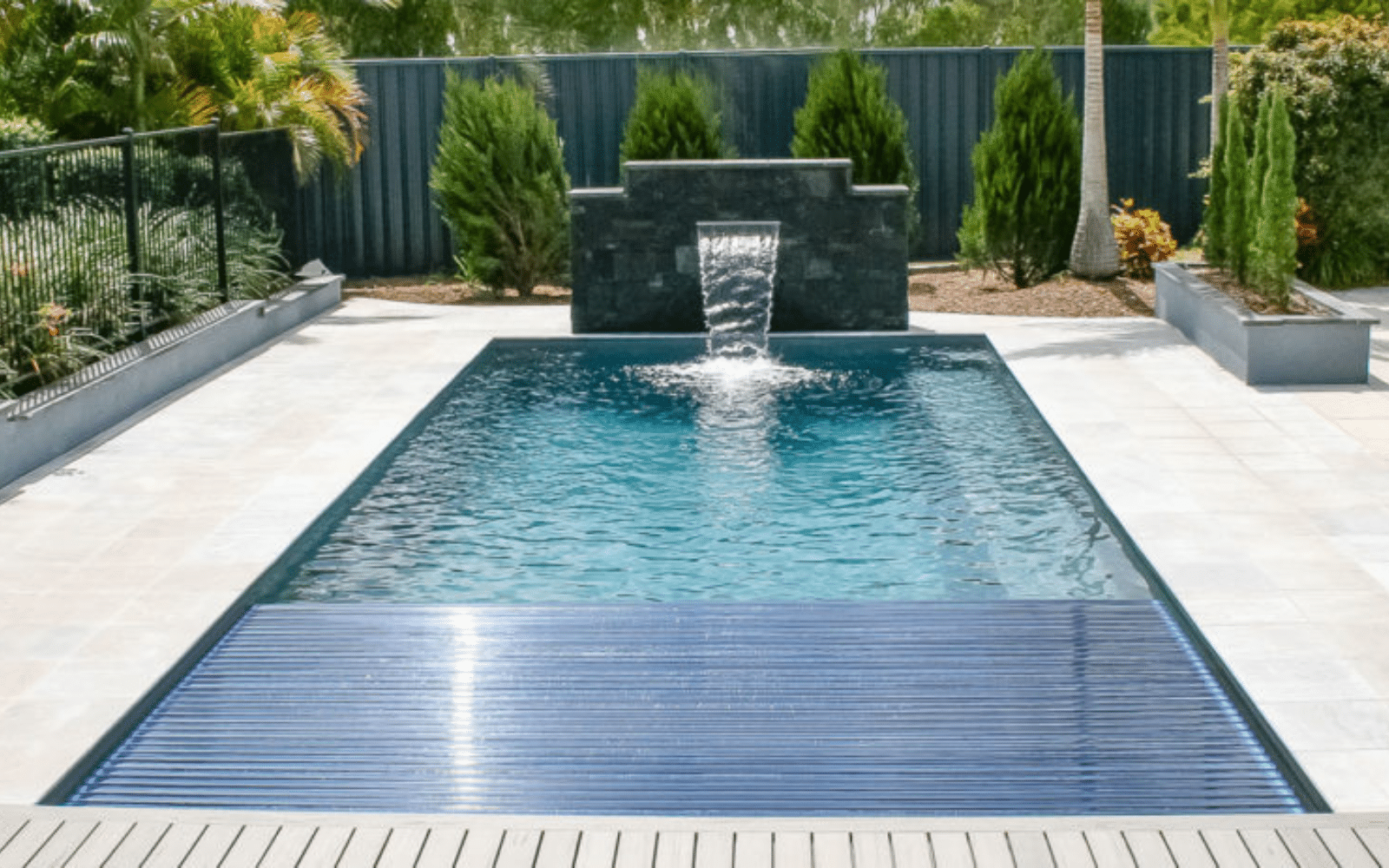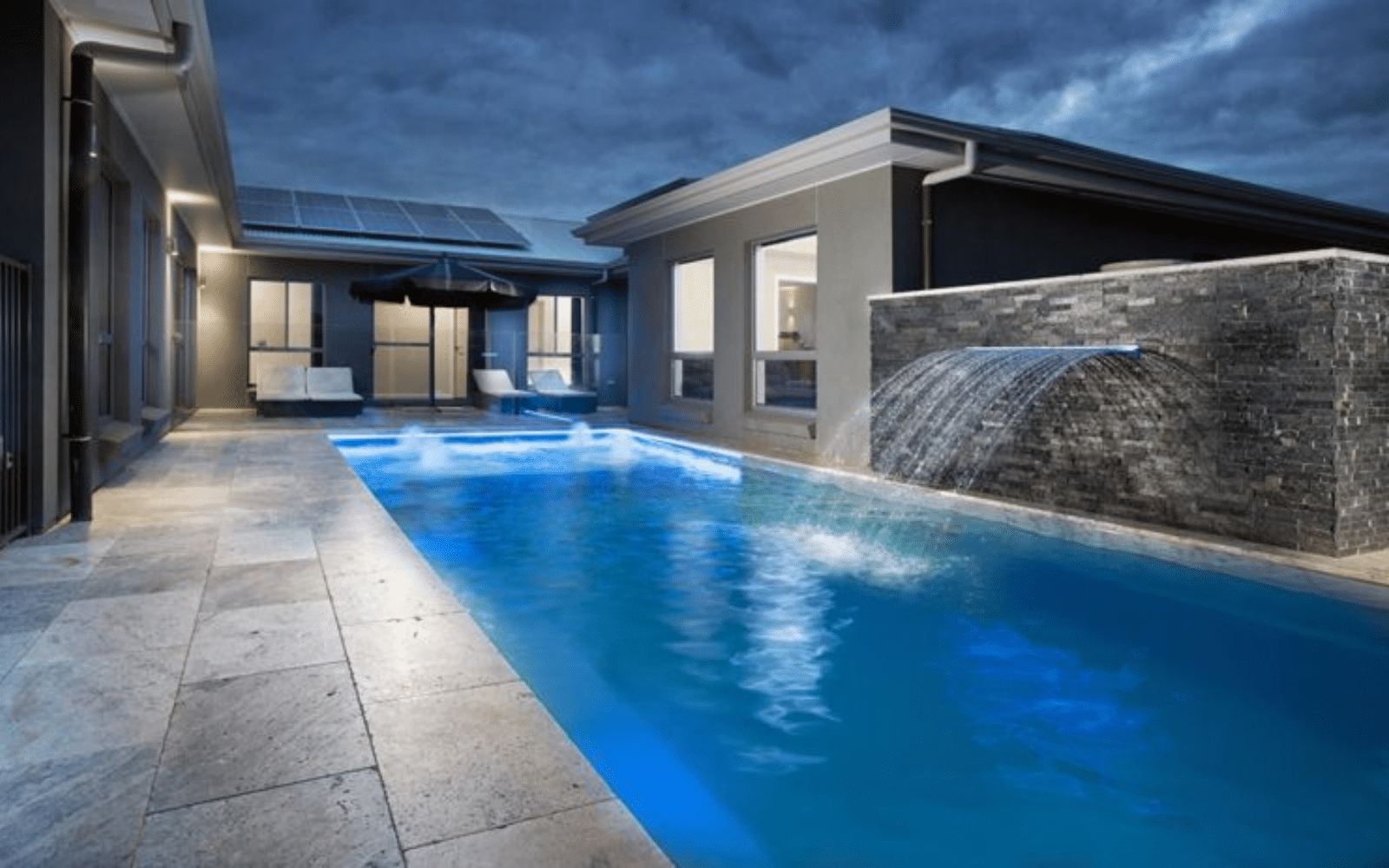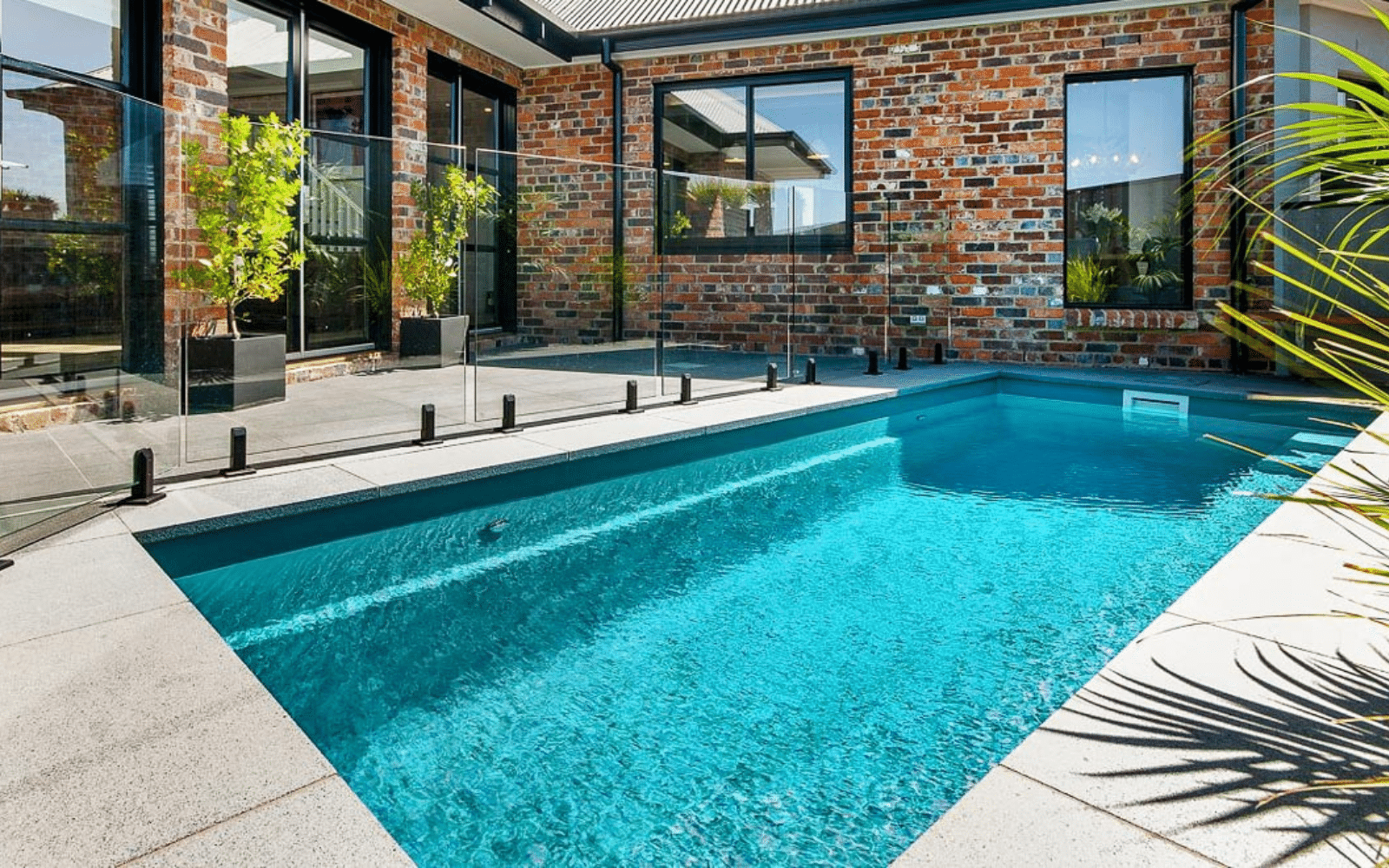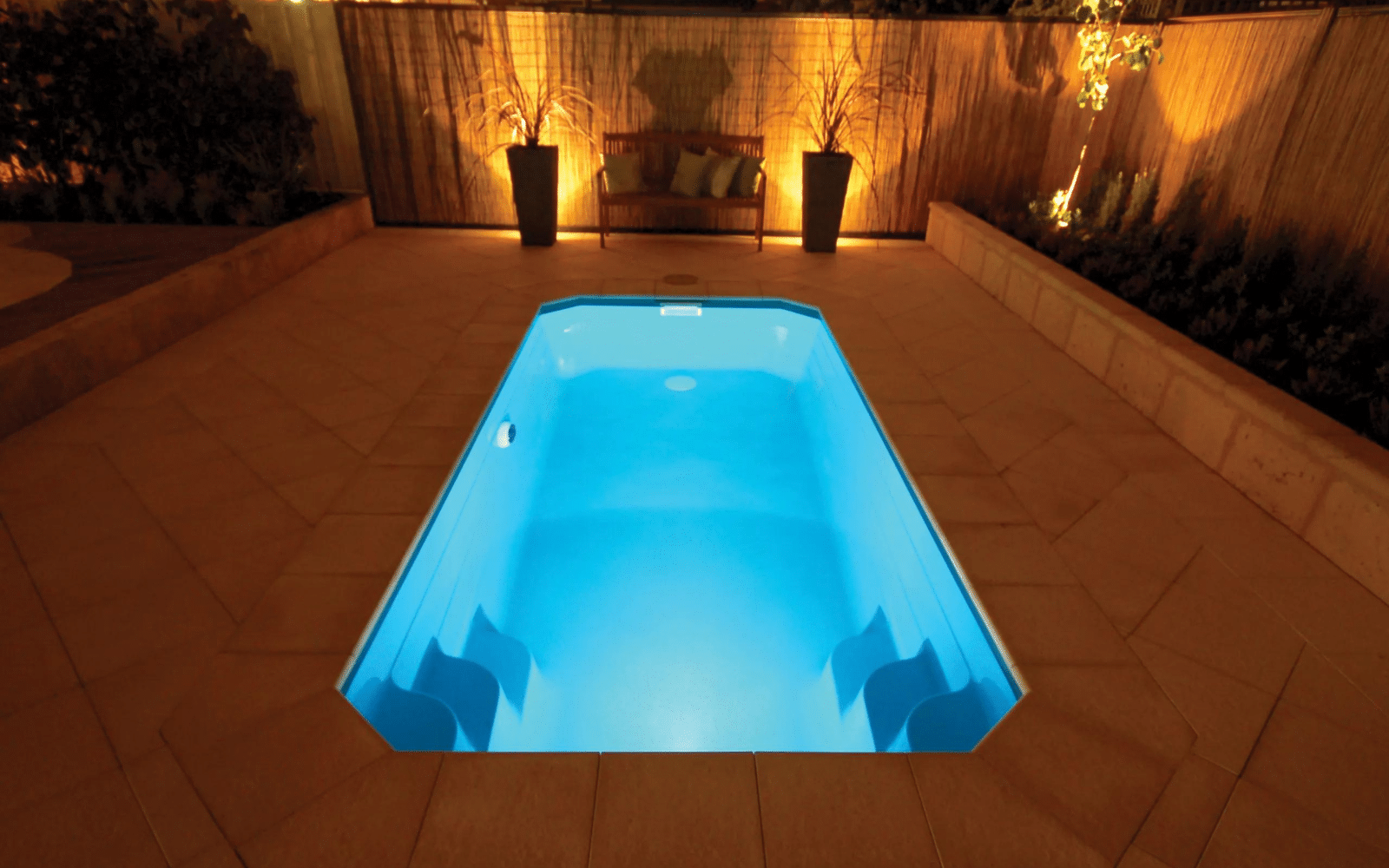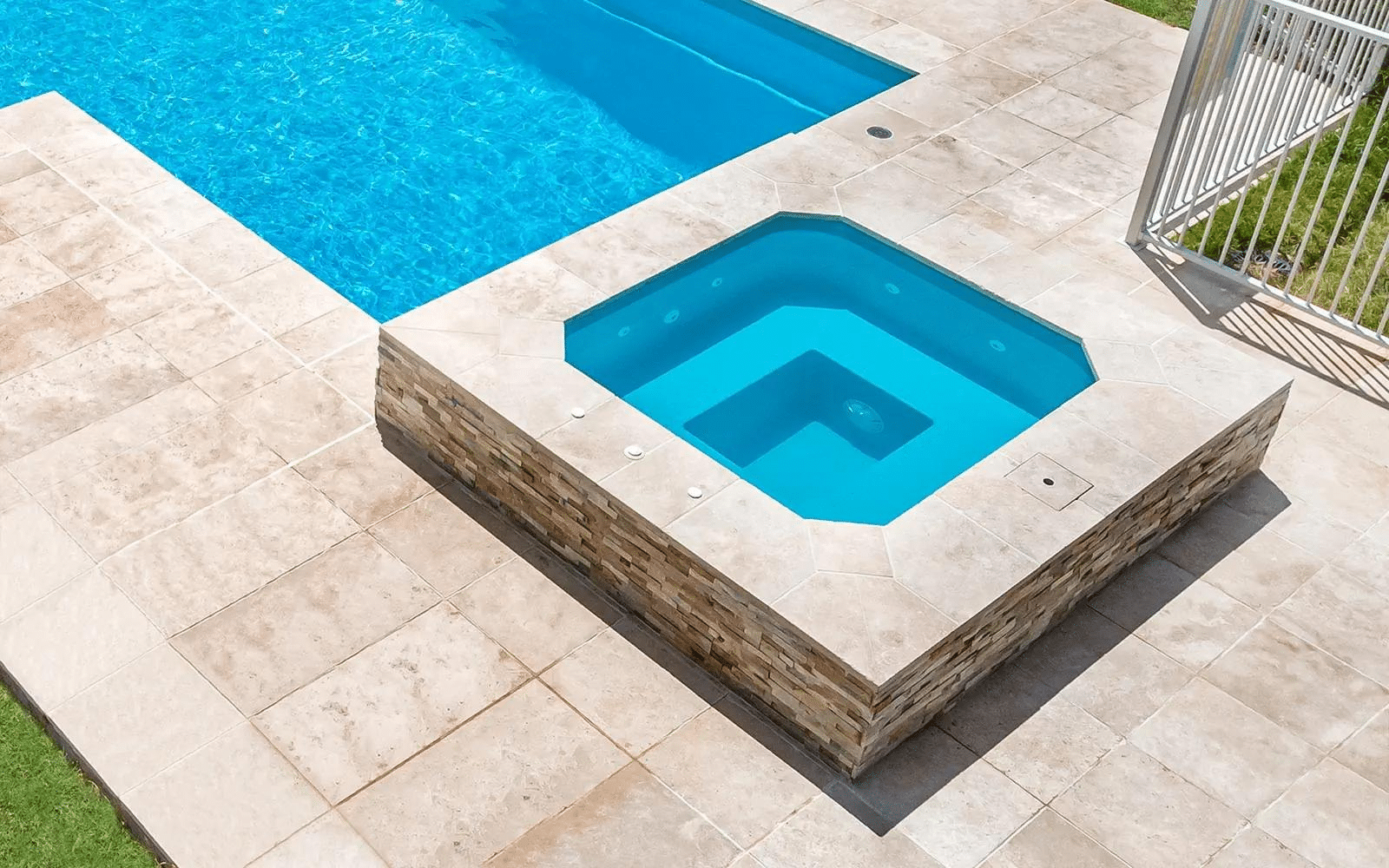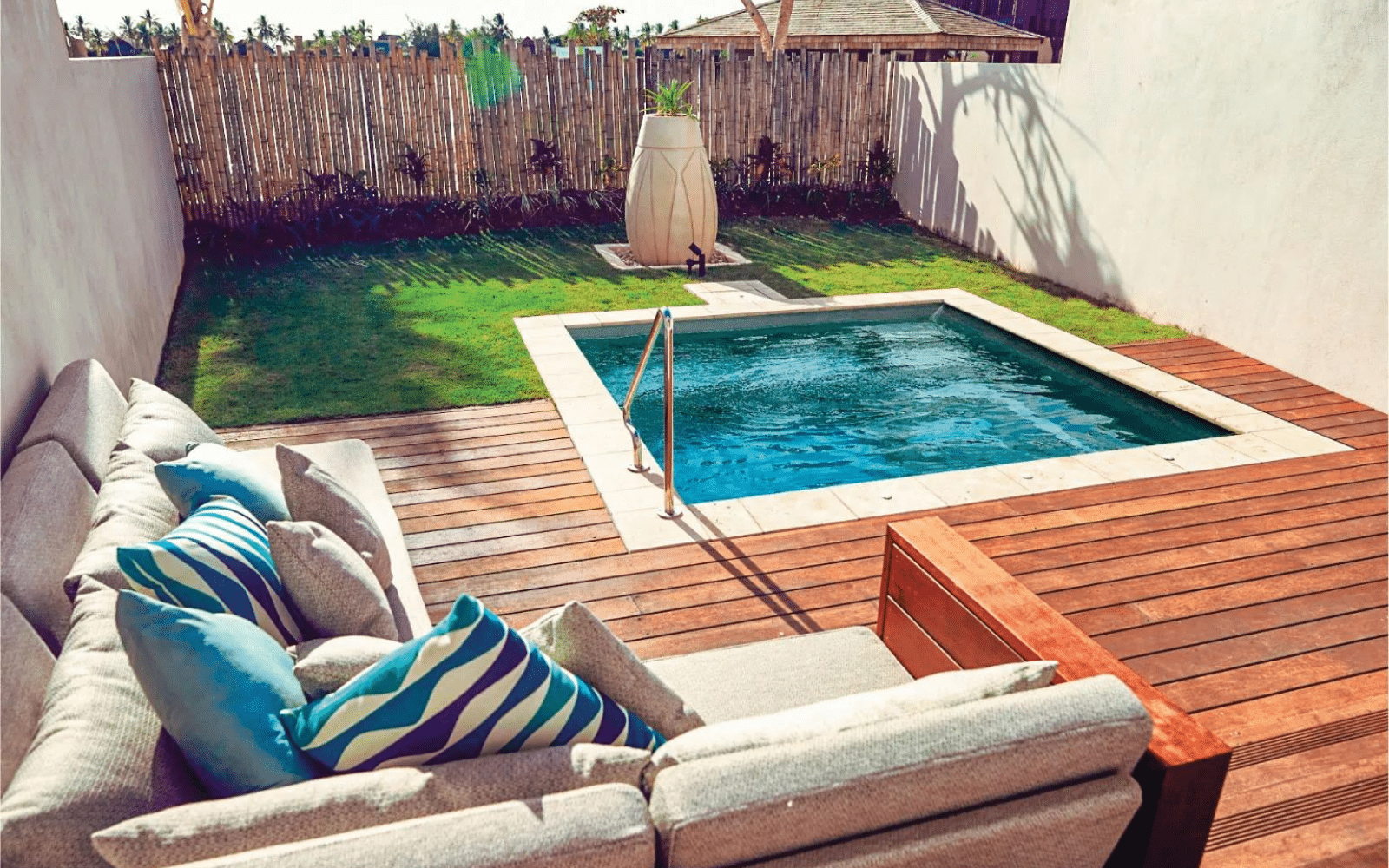Which is the best pool: Fibreglass, Concrete, or Vinyl?
Choosing the perfect pool for your backyard oasis can be challenging, especially when faced with multiple options. At Principal Pools, we understand how important this decision is for you. In this article, we’ll compare fibreglass, concrete, and vinyl liner pools, discussing their advantages and disadvantages to help you make an informed choice.
Okay, let’s dive in. First, let’s look at the following comparison chart that outlines specific pros and cons for each type of pool on a scale from one to five
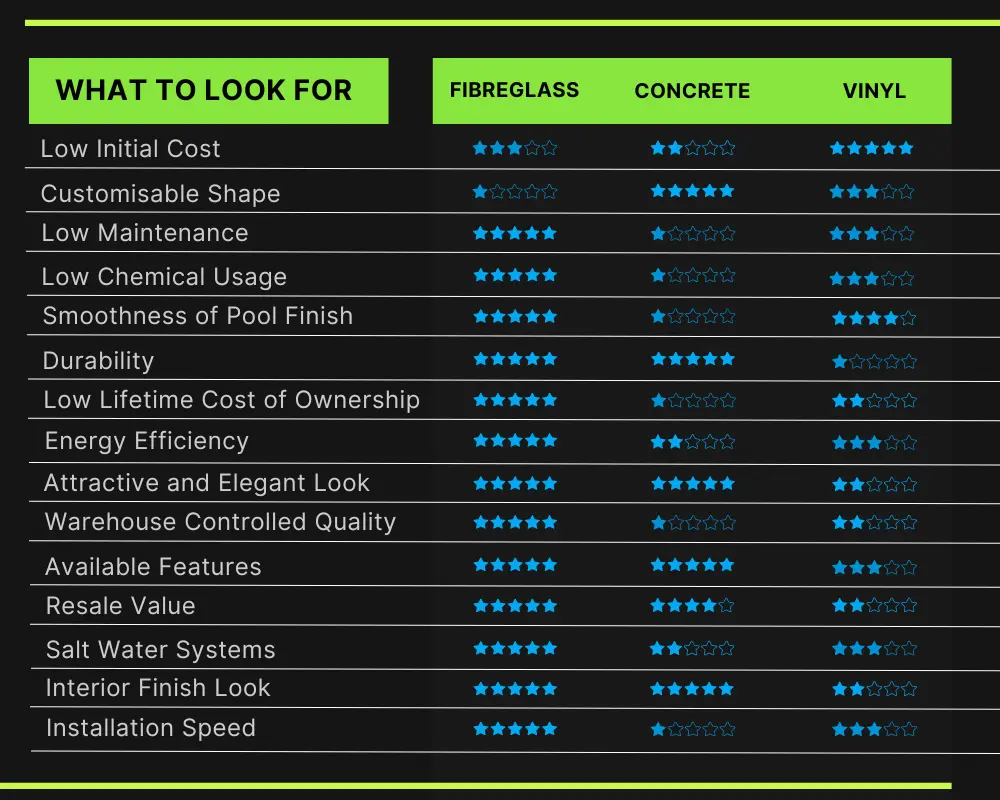
Let’s take a moment to talk about this chart. It’s clear to see that fibreglass swimming pools offer quite a few notable advantages compared to vinyl and concrete pools. However, it’s also important to consider that they do have some limitations if having a customisable shape and the higher price point is a factor for you.
Fibreglass Pool Advantages
Low Maintenance
Why are fibreglass pools so easy to maintain? It all has to do with surface porosity.
The surface of a fibreglass pool, called the gelcoat, is virtually non-porous. In contrast, the surface of a concrete pool is extremely rough and porous.
These rough cavities and pores give algae a place to hide and call home, making pool ownership much more challenging.
Concrete pool builders teach their clients that weekly brushing of the entire pool surface is essential to keep algae at bay.
Additionally, chemical usage in concrete pools is much higher because of the need to penetrate the pool surface to kill algae.
Concrete pools also require daily doses of muriatic acid to lower the pH of the water. This is because concrete is alkaline-based and constantly increases the pH of pool water. Fibreglass pools, on the other hand, are inert and do not affect water chemistry in any way.
For these reasons, fibreglass swimming pool owners typically spend 75% less time and money maintaining their pools. This means anyone who owns a fibreglass pool will spend more time in the pool and less time maintaining it.
Speed of Installation
Since the fibreglass pool shell is manufactured off-site, the installation of the shell typically occurs in about two days.
Compare this with three to six months with a concrete pool, and we’re talking about a massive difference in the duration of time your garden is in disarray…and often the difference between swimming this year or waiting until next summer.
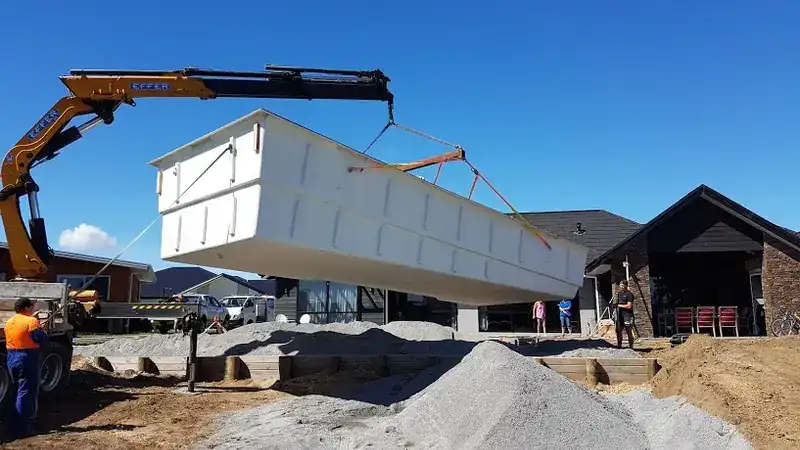
Durability
Because fibreglass swimming pools have no liner, there’s no need to worry about puncturing the pool surface.
Vinyl liners are not cheap…often upwards of $5–10k to replace. This can happen from dogs getting in the pool, tree branches, patio furniture blown into the pool, etc.
Fibreglass pools are incredibly strong and durable, so there’s no need to be concerned about damaging the pool during daily use.
Attractive Look
Over the past 30 years, fibreglass inground pools have transformed from the typical white bathtub you’d find at a rental beach house, to the elegant swimming pool designs and aesthetic features that are now as much works of art as the pool.
This is due to advancements in the industry such as beautiful coloured finishes, ceramic tile, tanning ledges, water features, stunning pool lights, elevated spas, poolside walls, etc.
This is one of the many reasons why fibreglass pools have gained exponential market share over the past decade.
Compatibility with Salt Systems
Salt chlorinators have proven to be a low maintenance, high water quality option for pool owners.
However, if you have ever seen what de-icing salt does to the surface of a pavement, you can guess what it does to the surface of a concrete pool. In our opinion, this makes the combination of salt systems and concrete pools unfavourable.
Also, many vinyl liner pools are constructed with metal wall panels, and most have aluminium coping around the perimeter of the pool. This is also a terrible scenario for a salt system. The liner will eventually leak, meaning goodbye wall panel!
In comparison, fibreglass pools and salt systems go together like peanut butter and jam.
With no adverse effect on the fibreglass shell, you can enjoy the low-maintenance benefits of salt with confidence that your pool is not compromised.
Resale Value
If a pool comes with the property, homebuyers want something that looks good, requires little maintenance, and will last a long time.
Vinyl liner pools need a new liner every 5–9 years, and often a buyer will require the current owners to replace it themselves.
Vinyl liner and above-ground pools don’t look great either, and can detract from the property’s value.
In contrast, a fibreglass pool adds to the value of your home. Low-maintenance beauty and durability are a win-win for both parties.
Although it won’t recoup the original cost of the pool itself, it does help… and the greatest value is the joy that the pool brings you and your family.
Low Lifetime Cost of Ownership
Take a look at the following chart to compare what the average pool owner would spend over a 10-year period with each type of pool:
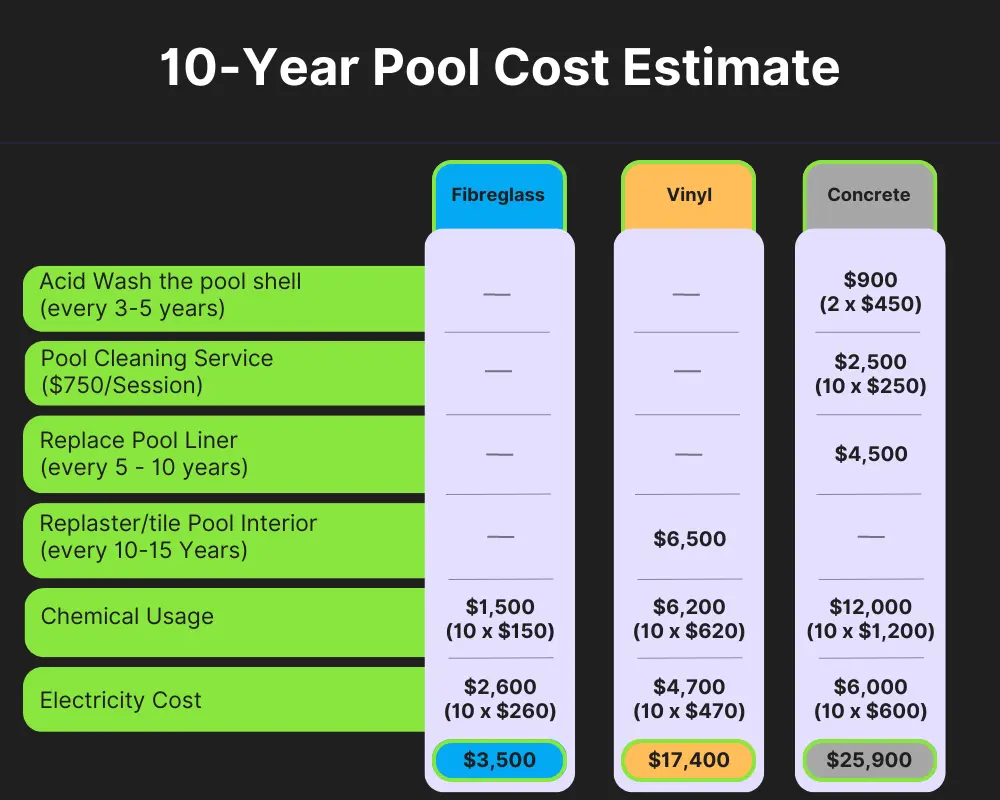
Fiberglass Pool Disadvantages
Higher Initial Cost than Vinyl Liners
The initial cost of a fibreglass pool is somewhat higher than that of a vinyl liner, typically ranging between $45,000 and $95,000.
However, as illustrated in the chart above, you end up spending significantly less in the long run when considering the cost of liner replacements every 5 to 9 years.
Limited Customisation of Swimming Pool Sizes and Shapes
The primary drawback of fibreglass inground pools is the inability to customise the shape, size, or depth of the pool.
So the question arises: can you find a fibreglass pool model that satisfies your requirements?
Our experience shows that around 90% of people do find a fibreglass pool that perfectly caters to their needs.
Nevertheless, if you’re seeking a pool that’s 3 Meters deep or requires an ultra-customised shape, fibreglass might not be the most suitable option for you.
However, at Principal Pools, we understand you want to get the most out of your investment when buying a pool, that’s why our pool range offers the largest swim space available in New Zealand.
Concrete Pool Advantages
Customisable Size and Shape
As you observed in the first chart above, concrete pools provide the flexibility to customise the shape of the pool. This is, without a doubt, their most significant advantage.
This is ideal for those wanting an exceptionally deep or large pool, or a pool with custom tanning ledges (which are also available in fibreglass) or other bespoke features.
Durable
Like fibreglass pools, the structure of concrete pools is incredibly durable.
There’s no concern with dog use or fear of damage to the pool interior from sharp objects, as is the case with vinyl liner pools.
However, concrete pool finishes, although tough, don’t last as long as the gelcoat surface of a fibreglass pool.
Concrete Pool Disadvantages
Understandably, the adaptability that concrete pools offer in terms of design comes with a set of disadvantages.
Hands-on Maintenance
Concrete, by its inherent characteristics, is highly porous, providing an ideal environment for algae to thrive.
When algae settle into the surface of a concrete pool, it becomes incredibly challenging to remove.
In fact, concrete pool specialists suggest using a steel brush to scrub the entire surface of the pool at least once a week to eliminate any algae present on the surface.
More Chemicals
Water chemistry presents an additional challenge for concrete pools.
As algae become embedded in the surface, a higher amount of chemicals are needed to penetrate and eliminate it.
This results in more time and money spent on maintaining the pool.
Furthermore, due to the alkaline nature of concrete, the pH level of the pool water consistently rises, necessitating regular acid additions to maintain a balanced pH.
Unsuitable for Saltwater
As previously noted, salt and concrete are not a good combination.
The presence of dissolved salt in the pool water can reduce the lifespan of a concrete pool’s interior finish, leading to more frequent refinishing requirements.
Overall Cost
As illustrated in the above chart, concrete pools have the highest total cost of ownership.
With an initial price tag ranging from 80,000 to 160,000 or more, they are a significant investment.
Additionally, expenses such as professional acid washing every three to five years, increased spending on chemicals and electricity, and periodic refinishing or remodelling contribute to tens of thousands of dollars in extra costs over the pool’s lifetime.
Rough Interior Surface
The coarse surface of a concrete pool not only encourages algae growth but can also be harsh on sensitive feet.
Many children who frequently play in concrete pools need to wear water shoes to prevent their feet from becoming sore and developing blisters.
I remember playing in my friend’s concrete pool back in 2008 and when jumping into the pool I hit my knee on the bottom surface of the pool, which actually hurt quite a bit and it was bleeding enough for it to need some sort of bandage.
Lengthy Installation Process
Compared to fiberglass and vinyl liner pools that can be finished within a few weeks, it’s quite common for concrete pool installations to take anywhere from three to six months or even longer.
This construction process not only impacts the backyard but can also be a strain on the family as well.
At least with fibreglass you will be able to start swimming within 2 days!
Vinyl Liner Pool Advantages
Lower Initial Investment
Vinyl liner pools offer a more cost-effective installation, typically ranging from $35,000 to $65,000.
This attractive feature makes it possible for numerous families to experience the advantages of an inground pool, even when working with a limited budget.
Flexible Shape Options
Although the majority of vinyl liner pools are rectangular, you can still tailor the pool’s shape, size, and depth to suit your preferences.
While custom shapes might come at a higher cost, they are generally more affordable compared to standard fibreglass or concrete pools.
Vinyl Liner Disadvantages
Liner Replacements
The most significant drawback of vinyl liner pools is the expense and frequency of liner replacements.
Modern vinyl liners typically have a lifespan of five to nine years, with an average replacement cost of around $5-10,000+. This takes into account the cost of the liner itself, labour, water to fill the pool, and other miscellaneous expenses that may arise.
As a result, the initially low cost of the pool may be offset within the first ten years following its construction. Over the pool’s entire lifetime, the total cost will likely be substantially higher than that of a fibreglass pool in the long run.
Warrenty Complications
Another aspect worth discussing is the liner warranty, which is often advertised as lasting for around twenty years.
We strongly recommend that anyone hoping for credit on a liner replacement takes the time to read the warranty in its entirety. Upon doing so, you’ll likely discover the following details:
- The warranty only covers the “seams” of the liner, which is where the sections of material are fused together.
- The warranty does not cover any labour, water, or other associated expenses.
- The warranty is heavily pro-rated. You may receive some credit towards a new liner during the first two or three years, but the amount will be significantly reduced after that period.
By understanding these points, you can make a more informed decision when considering the long-term costs of a vinyl liner pool.
Parts of Vinyl Liner Pools Can Foster Algae Growth
While the surface of a vinyl liner pool is relatively non-porous, there are certain areas of the pool where algae growth can occur. For example, places where the white plastic steps attach to the pool wall, and behind light niches, may have submerged sections that lack proper water circulation.
As a result, algae can grow in these spots and lead to further algae development. It’s essential to be aware of these potential issues when deciding on the best pool type for your needs.
Quick Breakdown
To help you determine the ideal pool type for your needs, here’s a brief summary of what we’ve discovered:
Concrete pools might be a suitable choice for those who:
- Have a budget of $100k and above
- Require a custom shape, or depth, or can’t find a suitable fibreglass pool
- Don’t mind dedicating a significant amount of time and/or money to pool maintenance
- Are comfortable with investing tens of thousands of dollars in the pool’s upkeep
Vinyl liner pools could be a good fit for those who:
- Have a budget of $35k–$65k
- Plan to live in the home for just two or three years (avoiding the first liner replacement)
- Desire the largest pool at the most affordable price
Fibreglass swimming pools might be ideal for those who:
- Have a budget of $50-80k and above
- Can find a fibreglass swimming pool design that meets their requirements
- Prefer low maintenance
- Want a pool that is cost-effective in the long run
- Seek a quick and relatively hassle-free installation process



